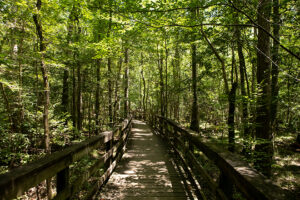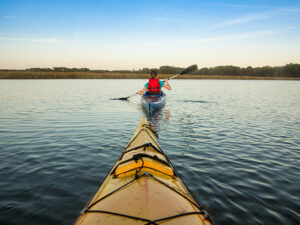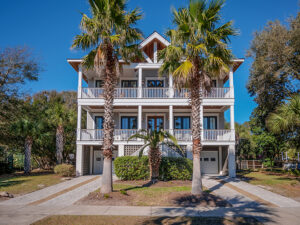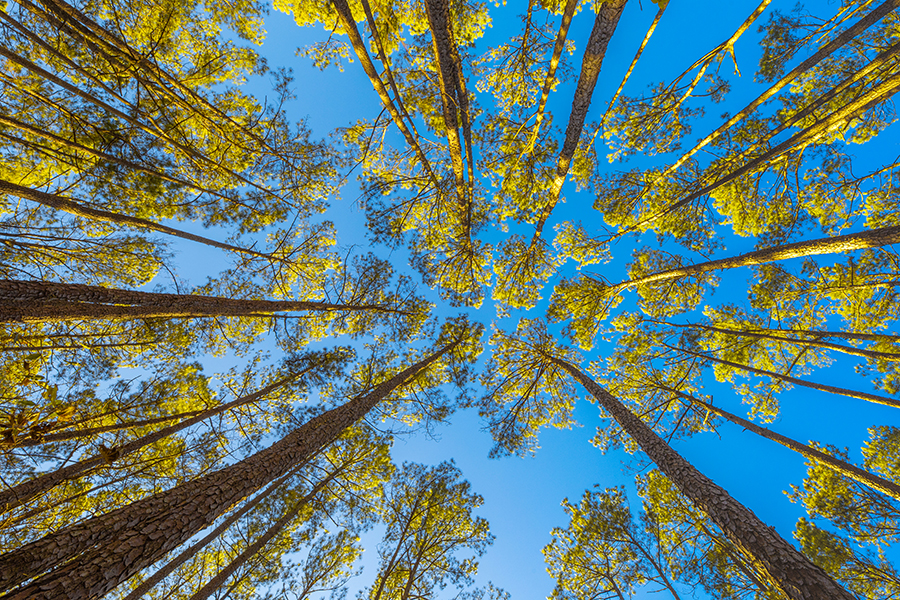The United States has 63 national parks, which are congressionally designated protected areas operated by the National Park Service. National parks are renowned for their natural beauty, unique geological features, diverse ecosystems, and recreational opportunities. Equity Estates residences enjoy close proximity to over a dozen national parks.
TOWERING TREES AND WINDING WATERWAYS
 Established in 2003, Congaree National Park is one of the country’s newest—and smallest—national parks, a unique southern woodland made up of 26,000 acres of old-growth bottomland forest, impressive oxbow lakes, streams, and meandering creeks, and some of the tallest trees east of the Mississippi. It’s an excellent day-trip destination, with opportunities for hiking, picnicking, fishing, or canoeing, all conveniently located just southeast of Columbia and two hours from the Equity Estates Isle of Palms home.
Established in 2003, Congaree National Park is one of the country’s newest—and smallest—national parks, a unique southern woodland made up of 26,000 acres of old-growth bottomland forest, impressive oxbow lakes, streams, and meandering creeks, and some of the tallest trees east of the Mississippi. It’s an excellent day-trip destination, with opportunities for hiking, picnicking, fishing, or canoeing, all conveniently located just southeast of Columbia and two hours from the Equity Estates Isle of Palms home.
Start your visit to Congaree with a quick stop at the Harry Hampton Visitor Center inside the park’s entrance. There you can check park conditions, explore exhibits, browse the small (but well-stocked) gift shop, and get an overview of the history and geology of the area from park rangers. It’s also the place to sign up for a guided hike or one of the other ranger-led programs.
If you decide to head out on your own, you may choose to keep to the easily accessible 2.4-mile Boardwalk Loop that cuts a scenic path through some of the park’s dense forest and swampy creek land, or venture off the boardwalk and on to any of the 25 miles of marked trails that lead to deeper forest. Just be prepared ahead of time with sturdy shoes, long pants, bug spray, and maps, as these trails can be rough and primitive and are often blocked by fallen trees and creeping plants and vines.
The wildlife in Congaree is typical for the southeast: turtles, deer, snakes, alligators, racoons, river otters, and even bobcats and wild pigs. Though most of the larger animals live in deeper parts of the forest and tend to keep their distance from visitors, there’s still plenty to watch for and enjoy from the safety of the trails. Keep your eyes and ears open to birds calling from the canopy overhead, common cotton mice or non-venomous indigo snakes rustling in the off-trail underbrush, and frogs and fish swimming lazily in the park’s lakes and ponds.
What the park is best known for:
Home to the largest intact expanse of old-growth bottomland forest in the southeast, with one of the tallest forest canopies in the world, Congaree is best known for its giant hardwoods, towering upland pines, and incredible biodiversity. Its rich, wilderness landscape, marshy wetlands, and gorgeous lakes and waterways provide sanctuary for native plants and animals and a tranquil setting for visitors to explore.
 Top three things to do in the park:
Top three things to do in the park:
Hiking
There are about a dozen marked hiking trails to choose from in Congaree National Park, ranging from the easy-to-navigate Boardwalk Loop to short, off-the-boardwalk paths and more primitive trails designed for longer treks into the backcountry forest.
The 2.4-mile boardwalk is perfect for hikers of all ages and skill levels, as the elevated trail is relatively flat and takes you past some of the park’s most stunning scenery—giant pines and beech trees, groves of Tupelos rising from water, cypress trees with “knees” emerging from soft, floodplain soil, and a wide variety of interesting undergrowth.
Bluff Trail and Sims Trail, both just past the visitor center, are good choices for guests who want to get out on a dirt trail but stay close to the boardwalk. The Weston Lake Loop Trail offers a moderate front-country challenge and picturesque views of the lake and Cedar Creek for those looking for a longer hike. And the River and Oakridge Trails are ideal for experienced hikers who want to spend a few hours out exploring Congaree’s backcountry.
Whichever path you choose, stay on marked trails, keep your eyes open for the many birds, reptiles, amphibians, and mammals that make their home within the forest, don’t feed the wildlife, and remember to bring bug spray, since the wetlands and standing water in the park mean lots of mosquitoes.
Canoeing and Kayaking 
Congaree is an excellent spot for canoeing and kayaking, full of slow-moving streams, sinuous lakes, and miles of South Carolina’s Cedar Creek, winding its way through the heart of the park, as it flows down to meet the Congaree River.
Guests can access a marked 15-mile water trail in the northwestern part of the park that takes you through the twists and turns of Cedar Creek, past stands of Champion trees and riverside flora teeming with frogs, insects, and small wildlife, along quiet stretches of water with green canopy reaching up and dappling the sunlight overhead—an incredible way to explore.
There are other trails to choose from, as well, including out-and-back upstream or downstream trails and longer, half-day and full-day treks if you’d like to plan a specific on-the-water day out.
Rent a canoe or kayak and paddle out on your own (making sure to check canoe trail conditions ahead of time) or book a guided river tour with one of the local outfitters. The park doesn’t offer rentals onsite, but they do provide a helpful list of approved vendors on their website.
Fishing
For more fun on or alongside the water, recreational fishing is one of the most popular year-round pastimes at Congaree, though there are a few rules to keep in mind. A valid South Carolina fishing license—easy to apply for and purchase online—is required. Boats with inboard/outboard motors aren’t allowed. Anglers may only use hook and line, fly rod, casting rod, pole and line, or hand line equipment. And fishing is permitted in all areas of the park, except within 25 feet of bridges and boardwalks.
With that in mind, there are many excellent spots within the park in which to cast your line, depending on what you’re hoping to catch. Striped bass are the most abundant species in the Congaree River (at the southern edge of the park), while catfish, bass, crappie and other fish populate Congaree’s many creeks and oxbow lakes.

About the Equity Estates home:
Our Isle of Palms residence is a custom-built, six-bedroom coastal vacation home with private pool and ocean views, just 30 minutes from downtown Charleston and two hours from Congaree National Park. It features beautiful pine flooring, custom woodwork, large windows and glass doors, a gourmet kitchen, game room, and elevator. Multiple porches, including a spacious wraparound front porch, offer relaxing outdoor living space on each level, while easy beach access just across the street will have you on the sand or in the water in no time.
